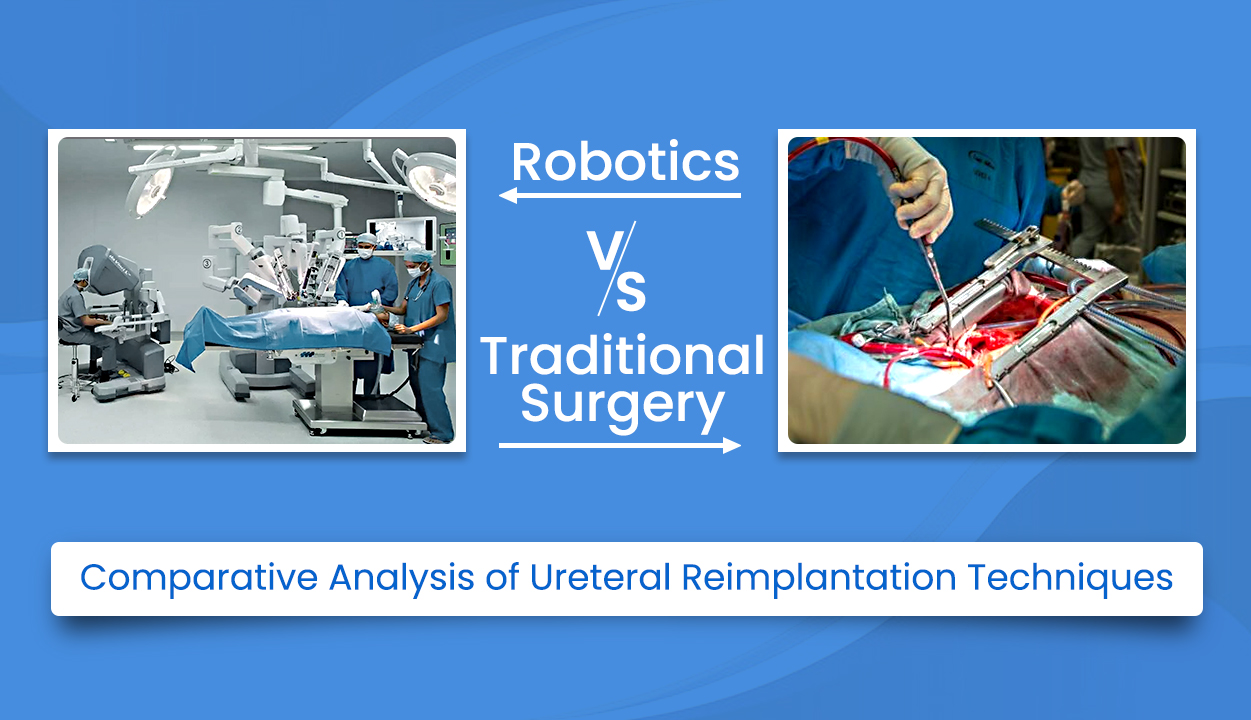
Robotics vs. Traditional Surgery: Comparative Analysis of Ureteral Reimplantation Techniques
Amidst the intricate workings of our body, there’s a vital pathway that keeps our urinary system in tune. This pathway is the ureter, a slender tube that guides urine from the kidney to the bladder. But, due to certain reasons, this flow may get disrupted. This is where ureteral reimplantation comes into the picture to restore balance and harmony.
Ureteral reimplantation is a surgical procedure that relocates the ureter, correcting issues like vesicoureteral reflux, where urine flows backward, causing kidney problems or infections. It’s also used for obstructions, congenital anomalies, and injuries to the ureter. This procedure establishes a new connection within the bladder to ensure proper urine flow, performed via open, laparoscopic, or robotic-assisted techniques. Surgeons evaluate each case individually, considering factors like patient health and condition severity, to determine the necessity of ureteral reimplantation in maintaining urinary and kidney health.
In this blog, we will delve into two techniques of ureteral reimplantation: traditional surgery and robotic surgery.
Traditional vs. Robotic surgery for Ureteral Reimplantation
Traditional Surgery
Traditional Surgery is performed by making a large incision in the abdomen or flank. The surgeon can directly visualize the ureter and its surrounding structures and make incisions and sutures.
Robotic Surgery
This is a minimally invasive approach. It is performed through several small incisions in the abdomen. The surgeon uses a robotic arm from a console to control tiny instruments inside the body. This allows for greater precision and less tissue damage than traditional surgery. It offers several advantages over traditional surgery, including:
- Greater precision: The robotic arm allows the surgeon to make more precise incisions and sutures than is possible with traditional surgery. This can help to reduce the risk of complications such as urinary leaks and strictures.
- Less tissue damage: Robotic surgery causes less tissue damage than traditional surgery. This can lead to a faster and easier recovery for the patient.
- Shorter hospital stay: Patients who undergo robotic ureteral reimplantation typically have a shorter hospital stay than those who undergo traditional surgery. The length of hospital stay can vary based on individual factors such as the patient’s overall health, the complexity of the procedure, and their specific needs during recovery.
- Improved cosmetic outcome: Robotic surgery leaves smaller incisions, which can lead to a better cosmetic outcome.
Benefits of Robotic Surgery for Ureteral Reimplantation
Beyond the mentioned advantages, robotic surgery offers further benefits that enhance patient outcomes and success rates:
- 3D Visualization: The robotic arm provides a 3D view of the surgical area, enhancing precision.
- Intraoperative Imaging: It enables ultrasound or cystoscopy for real-time issue identification.
- Flexibility: The robotic arm reaches challenging areas with ease.
- Ergonomics: Designed for surgeon comfort, reducing fatigue, and enhancing focus.
Surgical Decision-Making
Surgical decision-making involves a holistic consideration of factors, including patient age, overall health, and the extent of the obstruction or reflux.
For patients contemplating between traditional and robotic surgery, transparent conversations with our medical experts will be insightful. Gaining an understanding of the advantages and potential risks empowers patients in their surgical decision-making, leading to effective VUR correction and an improved quality of life.
In the comparative analysis of urologic procedures, the choice between traditional and robotic surgery for ureteral reimplantation stands pivotal. With its advantages in precision, reduced tissue trauma, shorter hospital stays, and superior aesthetic outcomes, robotic surgery emerges as an innovative and patient-centric approach. As healthcare evolves, robotic surgery stands as a testament to innovation, enhancing outcomes, and elevating patient well-being.
If you are considering robotic ureteral reimplantation, talk to our experts at Yashoda Kaushambi about the benefits and risks of this procedure. With careful planning and execution, robotic ureteral reimplantation can be a safe and effective way to correct VUR and improve your quality of life.
To consult an expert, book your appointment : click here.
